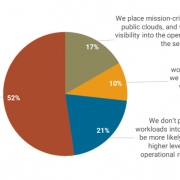COVID-19: IT organizations move from planning to implementation
Over the past few weeks, Uptime Institute held multiple customer roundtables to discuss the impact of the COVID-19 virus on data center operations and potential operational responses to its spread. We gathered our communities insights and best practices, we combined with our own 25 years worth of infrastructure operational management knowledge and we are now making this information available freely to the data center industry. HERE.
A little background to get you started right away….
Dozens of organizations were represented at these roundtables, which was open to a global audience of Uptime Institute Network membership. What we learned is that while most organizations have a plan for foreseen emergency situations, few have one specific to a global pandemic. As a result, many have been hurrily modifying existing plans based on gut feel and good intentions: creating tiered response levels, identifying events that would trigger the next level of response, researching concerns specific to a pandemic (e.g., what does “deep cleaning” mean in a white space, and what are the implications for different data center environments — raised floors, multi-tenant data centers, mixed-use facilities, etc.?).
But this is clearly unchartered territory for ALL of us. For many organizations, the Human Resources and/or Environmental Health & Safety department(s) take the lead in generating an organization-wide response plan, and specific business units, such as data center operations, incorporate that guidance into a plan tailored to their business mission and setting. Because many organizations have data centers in multiple regions, responses may vary by location or facility characteristics. A sample but very broad Emergency Response Plan by the US government’s FDA (with portions pertaining to the delivery of IT services contained within) can be seen here.
But immediately actionable tangible advice goes a long way in times like these. Several participants mentioned that their facilities now screen all potential visitors with a questionnaire. They do not admit anyone who reports symptoms (personally or in family members) or who has traveled recently to areas with high levels of COVID-19 cases. Some repondants advised that nn additional measure of their security involves prescreening all scheduled visitors: Send the visitor the questionnaire via email 4-8 hours prior to their visit and require completion before the appointment is confirmed. Only permit entry if the questionnaire indicates a low probability of infection (confirm all answers remain unchanged upon arrival) and prohibit unscheduled visitors altogether.
Some facilities – for example, multi-tenant data centers or mixed-use facilities – have a higher volume of visitors, and thus greater potential for COVID-19 spread. To avoid inconvenience and potential client dissatisfaction, be proactive: Inform all affected parties of the COVID-19 preparedness plan in place and its impact on their access to the facility in advance.
Sanitization is a particular challenge, with several participants reporting disinfectant/hand sanitizer shortages. Many had questions specific to deep cleaning the white space environment, given its high rate/volume of air exchange, highly specialized electronic equipment and possible raised floor configuration. Spray techniques are more effective than simply wiping surfaces with disinfectant solutions, as the antiseptic mist coats surfaces for a longer period. Many organizations are hiring specialist cleaning firms and/or following CDC recommendations for disinfection.
As COVID-19 spreads, more organizations are moving their energy from academicly tweaking their written response plans to implementing them. In many companies, that decision is made by a business unit, based on site environment, number of COVID-19 cases in the area and government-mandated restrictions. Mission-critical facilities have a particular remit, though, so need to create and implement plans specific to their business mission.
Good preparation simplifies decision-making. Roundtable participants suggest the following:
- Categorizing essential versus nonessential tasks and calendaring them in advance (makes it easier to identify maintenance items you can postpone, and for how long).
- Cross-training personnel and maintaining up-to-date skill inventories/certifications (helps ensure core capabilities are always available).
- Having contingency plans in place (means you’re prepared to manage supply chain disruption and staff shortages).
- Stress-testing technologies and procedures in advance (gives you confidence that you can accommodate a move to remote work: shifting procedures that are usually performed manually to an automated process, monitoring remotely, interacting virtually with other team members, etc.).
It’s no longer a question of if a plan like this will be needed, we know it is! Most facility operators need to quickly craft and then implement their response plan, and learn from this incident for the future.
Uptime Institute has created a number of resources and will be providing specific guidance regarding the COVID-19 situation here.

 2020
2020

 UI @ 2020
UI @ 2020




 2020
2020 2020
2020